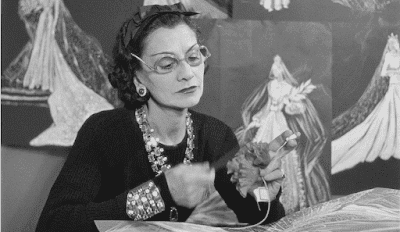Coco Chanel exhibition reveals fashion designer
was part of French resistance
Previously unseen documents to go on display at
V&A alongside evidence of her collusion with Nazis
Jess
Cartner-Morley
@JessC_M
Sat 9 Sep
2023 06.00 BST
A major
retrospective of Coco Chanel has unearthed evidence that the fashion designer
was a documented member of the French resistance. The previously unseen
documents will go on display, along with contradictory evidence that she
operated as a Nazi agent.
The
documents relating to Chanel’s activities in wartime Paris strike a serious
note within what is likely to be the most glamorous exhibition of the year,
with more than 50 tweed suits – including a bubblegum pink set belonging to
Lauren Bacall – on view at Gabrielle Chanel: Fashion Manifesto, when it opens
at the V&A in London on 16 September.
“We
couldn’t do a show about Chanel and not address her wartime record,” said the
curator, Oriole Cullen, who has expanded a show first created at the Palais
Galliera in Paris in 2020 with a new curation that delves more deeply into
Chanel’s links with Britain as well as her wartime activities.
Previously
unseen documents highlight the name “Gabrielle AKA Coco Chanel” on a list of
400,000 people whose part in the resistance is backed up by official records.
“We have verification from the French government, including a document from
1957, which confirms her active participation in the resistance,” said Cullen.
The museum
will also display strong evidence that Chanel collaborated with the Germans in
occupied Paris, including transcripts of postwar interrogation of three Nazi
officials who all separately name her as a trusted source.
“The new
evidence doesn’t exonerate her. It only makes the picture more complicated. All
we can say is that she was involved with both sides,” said Cullen.
In contrast
to the museum’s recent Dior show, which told the story of a fashion house that
has outlived its founder by 66 years, the Chanel exhibition ends with her death
in 1971. The exhibition is personal, and therefore, by dint of Chanel’s
controversial life, political.
Cullen
points to a childhood spent in a French convent after the death of her mother
and disappearance of her father as having produced a character whose
inclination for self-protection made her instinctively rightwing. She said the
designer was “more than anything a survivor, always on the lookout for
opportunities to move forward through life”.
During the
early 1940s, Chanel had a relationship with the Nazi officer Baron Hans Günther
von Dincklage, which she leveraged to free her nephew, Andrré Palasse, from a
German prisoner-of war-camp.
“We did not
want to ignore her wartime record – but first and foremost, this is a fashion
exhibition,” said Cullen.
Fragile
evening pieces usually stored under wraps in the museum’s archive will be on
display, along with the groundbreaking “evening trousers” with which a young
Chanel scandalised French society. One room will tell the story of Chanel’s No
5 perfume, which became a signature scent worn by leading figures from Marilyn
Monroe to Andy Warhol.
Many of the
100 pieces added to the show since the version shown in Paris delve into her
connections with Britain. A portrait in oils of Chanel, painted by Winston
Churchill, attests to a close relationship with British society forged through
her romance with the Duke of Westminster. The Nazis had given the designer the
code name of “Westminster”.
The show
also highlights her less well-known connection to British manufacturing. On
display will be a tomato red evening gown in silk velvet, with matching
elbow-length gloves, made for Chanel by the Manchester Velvet company in 1932.
During that decade, Coco established a company – British Chanel Ltd – for the
manufacture of her designs in British fabrics including Northern Irish linens,
and Nottingham lace.
“Chanel was
highly exacting, so the connection attests to the existence of a high-quality
textile industry in Britain, which sadly no longer exists,” said Cullen.

No comments:
Post a Comment